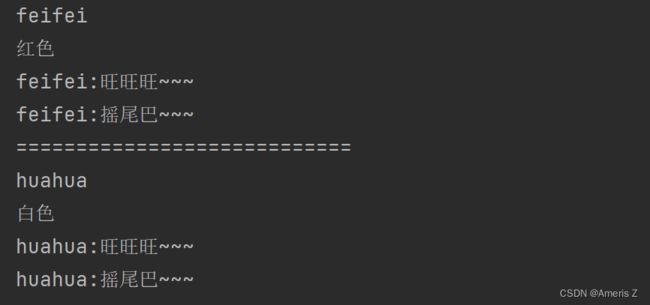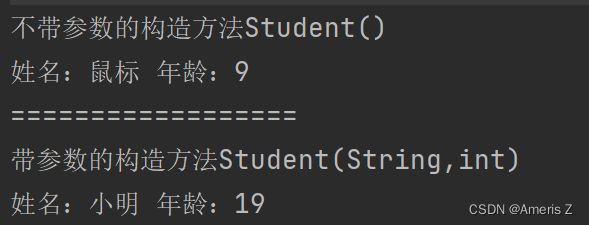Java类和对象(重点:this引用、构造方法)
目录
一、类的定义方式以及实例化
1.面向对象
Java是一门纯面向对象的语言(Object Oriented Program,简称OOP),在Java的世界里一切皆为对象。
2.类的定义和使用
1.在java中定义类时需要用到class关键字
3.类的实例化
4.类实例化的使用
二、this引用
例子1:this能区分调用方法的对象。
例子2:this区分局部变量和引用对象。
例子3:建议给对象都加上this.
三、对象的构造及初始化
1.初始化对象
1.通过引用赋值来初始化
2.就地初始化:定义成员变量的同时初始化。(一般不用)
2.构造方法
(1) 不带参数的构造方法
1.这个构造方法是如何被调用的???
2.那为什么之前没有写构造方法的时候,也能正常执行show方法呢???
(2) 带参数的构造方法
1.构造方法可以有多个 且 构造方法之间构成重载关系
2.一旦自己写了构造函数,编译器不会自动提供了
3.构造函数快捷键生成
4.使用this()在构造方法内,调用其他构造方法
this()这个语法只能出现在构造方法当中
只能出现在当前构造方法的第一行!!!
注意:不能自己调用自己!!!
(4)this引用的小总结
一、类的定义方式以及实例化
1.面向对象
Java是一门纯面向对象的语言(Object Oriented Program,简称OOP),在Java的世界里一切皆为对象。
举个例子:洗衣服
面向过程:人 - 把洗衣粉倒进盆里 - 打开水龙头 - 放衣服 - 搓衣服 - 清水洗 - 再放洗衣粉 - 搓衣服 - 清水洗 - 扭干衣服
面向对象: 人 - 洗衣粉 - 洗衣机
至于洗衣机是左旋转几圈还是右旋转几圈,不在乎洗的过程。
2.类的定义和使用
类是用来对一个实体 ( 对象 ) 来进行描述的 ,主要描述该实体 ( 对象 ) 具有哪些属性 ( 外观尺寸等 ) ,哪些功能 ( 用来干 啥) ,描述完成后计算机就可以识别了定义了一个类,相当于在计算机中定义了一种新的类型
1.在java中定义类时需要用到class关键字
class WashMachine{
//属性
public String brand; // 品牌
public String type; // 型号
public double weight; // 重量
public String color; // 颜色
//方法
public void washClothes(){ // 洗衣服
System.out.println("洗衣功能");
}
public void dryClothes(){ // 脱水
System.out.println("脱水功能");
}
public void setTime(){ // 定时
System.out.println("定时功能");
}
}3.类的实例化
实例化 :用 定义的类 创建对象,就是类的实例化
用new关键字实例化对象(同一个类可以实例化多个对象)以下代码:
PetDog petDog1 = new PetDog();
同理PetDog petDog2 = new PetDog();就是在实例化对象
类相当于是一个模型,用这个模型可以造出很多个对象。所以可以实例化多个对象。
class PetDog{
//狗的属性
public String name;//名字
public String color;//颜色
//狗的行为
public void barks(){
System.out.println(name + ":旺旺旺~~~");
}
public void wag(){
System.out.println(name + ":摇尾巴~~~");
}
}
public class Test2 {
public static void main(String[] args) {
//实例化 :定义了一个类,相当于在计算机中定义了一种新的类型
//用 定义的类 创建对象,就是类的实例化
//用new关键字实例化对象(同一个类可以实例化多个对象)
PetDog petDog1 = new PetDog();
petDog1.color = "红色";
petDog1.name = "feifei";
//访问实例化对象的属性
System.out.println(petDog1.name);
System.out.println(petDog1.color);
//调用实例化对象的行为
petDog1.barks();
petDog1.wag();
System.out.println("============================");
PetDog petDog2 = new PetDog();
petDog2.color = "白色";
petDog2.name = "huahua";
//访问实例化对象的属性
System.out.println(petDog2.name);
System.out.println(petDog2.color);
//调用实例化对象的行为
petDog2.barks();
petDog2.wag();
// System.out.println(petDog1);//对象的地址
// System.out.println(petDog2);
}
}
4.类实例化的使用
给对象赋值
打印实例化对象的属性,以及 .方法 来调用方法
结果:
二、this引用
this引用指向当前对象 ( 成员方法运行时调用该成员方法的对象 ) ,在成员方法中所有成员变量的操作,都是通过该 引用去访问 。只不过所有的操作对用户是透明的,即用户不需要来传递,编译器自动完成。作用:
1.能区分调用方法的对象。 date调用的,就对date操作;date2调用的,就对date2操作。 2.区分局部变量和引用对象。 避免形参名与对象名相同时,局部变量自己赋值。
例子1:this能区分调用方法的对象。
方法只有1个,现在有两个实例化对象date和date2,那么在调用这个方法的时候,我们怎么确定
这个方法是给date赋值,还是在给date2赋值?
date.setDate(1999,1,1);//调用setDate方法,传参 1999,1,1
date2.setDate(2000,2,2);//调用setDate方法,传参 2000,2,2
虽然在调用的时候,有写date或者date2,但是进入方法以后,谁知道谁是谁呢?
其实,这个方法有个隐藏的函数,Date.this
public class Date {
//属性
public int year;//public int year = 2023;//一般不写值,写了相当于默认值
public int month;
public int day;
//方法
public void setDate(int y,int m,int d){
year = y;
month = m;
day = d;
}
}
public void print(){
System.out.println("year:"+year+" month:"+month+" day:"+day);
}
public static void main(String[] args) {
Date date = new Date();//实例化一个date
date.setDate(1999,1,1);//调用setDate方法,传参 1999,1,1
// 然后进入该方法,y,m,d根据方法里的内容赋值
Date date2 = new Date();//又实例化一个date2
date2.setDate(2000,2,2);//调用setDate方法,传参 2000,2,2
date.print();
date2.print();
}
}
例子2:this区分局部变量和引用对象。
给当 传入的形参名,与被赋值的对象名不同时,加不加this,没有任何影响,打印出来时正常的。 相同时,例如:此时形参名year和对象名 year相同,此时赋值,受局部变量优先的影响,形参(year)自己给自己赋值, 这样打印的结果就不是正常的
得到的结果:
public class Date {
//属性
public int year;//public int year = 2023;//一般不写值,写了相当于默认值
public int month;
public int day;
//方法
public void setDate(int year,int month,int day){
year = year;
month = month;
day = day;
public void print(){
System.out.println("year:"+year+" month:"+month+" day:"+day);
}
public static void main(String[] args) {
Date date = new Date();//实例化一个date
date.setDate(1999,1,1);//调用setDate方法,传参 1999,1,1
// 然后进入该方法,y,m,d根据方法里的内容赋值
Date date2 = new Date();//又实例化一个date2
date2.setDate(2000,2,2);//调用setDate方法,传参 2000,2,2
date.print();
date2.print();
}
}
例子3:建议给对象都加上this.
又得到了预期的结果
所以建议以后写,都加上this,避免这些容易犯的错误
public class Date {
//属性
public int year;//public int year = 2023;//一般不写值,写了相当于默认值
public int month;
public int day;
//方法
public void setDate(Date this,int year,int month,int day){
this.year = year;
this.month = month;
this.day = day;
}
public void print(){
System.out.println("year:"+year+" month:"+month+" day:"+day);
}
public static void main(String[] args) {
Date date = new Date();//实例化一个date
date.setDate(1999,1,1);//调用setDate方法,传参 1999,1,1
// 然后进入该方法,y,m,d根据方法里的内容赋值
Date date2 = new Date();//又实例化一个date2
date2.setDate(2000,2,2);//调用setDate方法,传参 2000,2,2
date.print();
date2.print();
}
}
三、对象的构造及初始化
1.初始化对象
1.通过引用赋值来初始化
在定义属性的时候一般不赋值,也就是不初始化。
与局部变量不同,局部变量在使用前必须初始化,否则会报错。 而成员变量没有初始化时,有一个默认值。比如int - 0,float - 0.0f,double - 0.0,boolean - false,char - '\u0000' 引用类型例如String - null
2.就地初始化:定义成员变量的同时初始化。(一般不用)
就地初始化:有特殊的业务需求,比如任何一次对象的实例化之后,都期望这个对象叫张三 或者年龄都是9
class Student{
public String name ;//没有初始化,默认为null
public int age ;//没有初始化,默认为0
//public String name = "张三";
//public int age = 9;
public void eat() {
System.out.println(this.name+"吃饭!");
}
public void show(){
//this.eat();//可以在成员方法里,调用另一个成员方法
System.out.println("姓名:"+this.name+" 年龄:"+this.age);
}
}
public class Test {
public static void main(String[] args) {
/**
* 实例化对象
*/
Student student = new Student();
//同过对象的引用来初始化
student.name = "zhangsan";
student.age = 10;
student.show();
System.out.println("====================");
Student student2 = new Student();
student2.name = "lisi";
student2.age = 15;
student2.show();
}
}
2.构造方法
构造方法(也称为构造器)是一个特殊的成员方法,名字必须与类名相同,在创建对象时,由编译器自动调用,并且 在整个对象的生命周期内只调用一次。
构造方法:(非常特殊!!)1.没有返回值
2.方法名必须和类名一样
特性1. 名字必须与类名相同2. 没有返回值类型,设置为 void 也不行3. 创建对象时由编译器自动调用,并且在对象的生命周期内只调用一次 ( 相当于人的出生,每个人只能出生一次 )4. 构造方法可以重载 ( 用户根据自己的需求提供不同参数的构造方法 )这是当前类这是类里写的构造方法
(1) 不带参数的构造方法
class Student{
public String name ;//没有初始化,默认为null// 就地初始化:定义成员变量的同时初始化。public String name = "张三"
public int age ;//没有初始化,默认为0 //public int age = 9
public void eat() {
System.out.println(this.name+"吃饭!");
}
public void show(){
//this.eat();//可以在成员方法里,调用另一个成员方法
System.out.println("姓名:"+this.name+" 年龄:"+this.age);
}
//构造方法
public Student(){
this.name = "鼠标";
this.age = 9;
System.out.println("构造方法Student()");
}
}
public class Test {
public static void main(String[] args) {
Student student = new Student();
student.show();
}
}
1.这个构造方法是如何被调用的???
运行代码时,发现调用show()方法之前,先调用了构造方法Student()
在new Student()这先调用了构造方法public Student,然后在这个构造方法里赋值了,打印了 ”构造方法Student()“这个内容。然后调用了student.show,将属性打印出来 姓名:鼠标 年龄:9
2.那为什么之前没有写构造方法的时候,也能正常执行show方法呢???
因为,当我们没有写任何一个构造方法的时候,Java会自动提供一个不带参数的构造方法。就是这个样子
public Student(){ }
(2) 带参数的构造方法
1.构造方法可以有多个 且 构造方法之间构成重载关系
class Student{ public String name ;//没有初始化,默认为null// 就地初始化:定义成员变量的同时初始化。public String name = "张三" public int age ;//没有初始化,默认为0 //public int age = 9 public void eat() { System.out.println(this.name+"吃饭!"); } public void show(){ //this.eat();//可以在成员方法里,调用另一个成员方法 System.out.println("姓名:"+this.name+" 年龄:"+this.age); } /** * 构造方法 */ //不带参数的构造方法 public Student(){ this.name = "鼠标"; this.age = 9; System.out.println("不带参数的构造方法Student()"); } //带参数的构造方法 public Student(String name,int age){ this.name = name; this.age = age; System.out.println("带参数的构造方法Student(String,int)"); } } public class Test { public static void main(String[] args) { Student student = new Student(); student.show(); System.out.println("=================="); Student student2 = new Student("小明",19); student2.show(); } }运行结果
可以发现:
1.构造方法可以有多个
2.一旦自己写了构造函数,编译器不会自动提供了
假如此时把不带参数的构造方法删掉,就会报错了
class Student{
public String name ;//没有初始化,默认为null// 就地初始化:定义成员变量的同时初始化。public String name = "张三"
public int age ;//没有初始化,默认为0 //public int age = 9
public void eat() {
System.out.println(this.name+"吃饭!");
}
public void show(){
//this.eat();//可以在成员方法里,调用另一个成员方法
System.out.println("姓名:"+this.name+" 年龄:"+this.age);
}
/**
* 构造方法
*/
//带参数的构造方法
public Student(String name,int age){
this.name = name;
this.age = age;
System.out.println("带参数的构造方法Student(String,int)");
}
}
public class Test {
public static void main(String[] args) {
Student student = new Student();
student.show();
System.out.println("==================");
Student student2 = new Student("小明",19);
student2.show();
}
}
不是说,编译器会自动提供不带参数的构造方法吗??这里为什么又会报错呢??
原因很简单,当一个构造函数都没有的情况下,才会默认自动提供一个不带参数的
构造方法。目前没有不带参数的构造方法,但是有一个带参数的构造方法,就不会提供了。
以自己编写的这个带参数的构造方法为主,此时,new Student()实例化一个新的对象,里面没有带参数,而自己写的那个是带参数的,所以就报错了。
3.构造函数快捷键生成
如果有太多构造函数需要编写,IDEA有一个快捷键,一键生成。
快捷键 alt+insert ,或者 鼠标右键
4.使用this()在构造方法内,调用其他构造方法
this()这个语法只能出现在构造方法当中
只能出现在当前构造方法的第一行!!!
注意:不能自己调用自己!!!
成功调用
只能出现在构造方法的第一行!!!
下面这个就错了!!
(4)this引用的小总结
1.this.成员变量
2.this.成员方法
3.this()在构造方法里调用其他构造方法
注意!!this代表当前对象的引用,而不是当前对象。
因为实例化对象的重要两步是:
1.为对象分配内存
2.调用合适的构造方法
而在调用构造方法的时候,this还在其中使用,所以是对当前对象的印象!!!
























